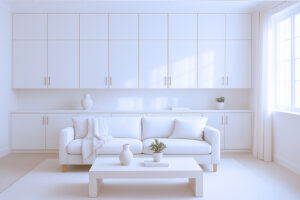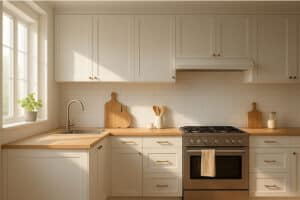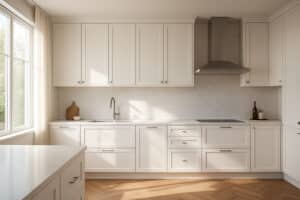Bring timeless sophistication to your space with this guide to monochromatic interior design services.
What is Monochromatic Interior Design?
Monochromatic interior design incorporates different shades, tints, and tones of one color to establish a harmonious, unified space. Rather than combining multiple colors, this style explores the depth within one palette. For example, layering off-white, pure white, and cream can produce subtle dimension within a unified scheme. As a result, monochromatic interiors feel balanced, refined, and visually calm.
What are the Design Principles Behind Monochrome?
The core principle of monochromatic interior design is unity. By working within a single color family, you can use contrast, texture, and light to maintain visual interest. This approach also allows you to layer varying saturations from light to medium to dark to create depth and balance.
How to Create a Monochromatic Interior: Step-by-Step
- Choose Your Base Color:
Begin with a color that aligns with the mood you want to create. Cool blues promote calm, earthy browns add warmth, and deep greys deliver a modern edge.
- Select Variations:
Incorporate lighter and darker tones of the chosen hue across walls, furniture, and décor elements.
- Add Texture:
Use materials such as velvet, linen, wood, stone, or subtle patterns to add depth and avoid a flat look.
- Balance the Lighting:
Combine ambient, task, and accent lighting to enhance dimension and maintain visual interest.
- Introduce Accents:
Add metallic touches or a single contrasting accent within the same color family to create subtle visual contrast.
Pros and Cons of Monochromatic Interior Design
Pros:
- It creates timelessness
- Adds a serene, unified aesthetic
- It’s easy to style and update with accessories
Cons:
- The colour might feel flat if texture and lighting are ignored
- You will have a limited colour variety, which may not appeal to everyone
- It requires thoughtful layering to avoid a sterile look
Our blog explores the versatility and elegance of monochromatic color schemes in interior design and offers practical tips for incorporating them into your home. Below are a few styles you can consider.
Dark Monochromatic Interior Design
A monochromatic color scheme uses varying shades, tones, and tints of a single color to create a cohesive aesthetic. This streamlined approach lets you explore light and dark variations within one palette, adding depth and interest without overwhelming the space. By balancing these subtle differences, you can achieve a sophisticated and visually elevated interior design.
Layering Monochromatic Colour Scheme Interior Design
One of the core principles of a monochromatic color scheme is creating depth and dimension by combining light and dark variations of the same hue. For example, this yellow-to-orange sunset palette in a kitchen–dining area brings a refreshing vibrancy to the space. By layering these tones, you add visual interest and prevent the room from appearing flat or monotonous.
Brown Monochromatic Colour Scheme: Interior Design Ace
To keep a monochromatic color scheme from feeling flat, incorporate texture and pattern throughout the space. Textured fabrics such as velvet, linen, and wool add depth and tactile interest to furniture and accessories. Additionally, subtle patterns—like stripes, chevrons, or geometric prints break up visual monotony while preserving the cohesion of the overall design.
Grey Monochromatic Room Design: Neutrals Rule
While monochromatic color schemes center on a single shade, adding complementary or contrasting accents enhances balance and visual interest. For instance, in a mostly grey and beige bedroom, introducing warm wood tones or vibrant accessories such as stools, wall lights, or artwork creates depth and personality. These accents break up the uniformity of the palette and bring warmth to the space.
A Beige Monochromatic Interior Design for Bedroom
Elevate your bedroom’s sophistication with a refined monochromatic design. In this space, beige anchors the interior, while golden lighting enhances its warmth. Soft white walls provide gentle contrast, and dark grey and brown upholstery introduce subtle depth. Together, these elements create a balanced and elegant monochrome aesthetic.
A monochromatic colour scheme offers a versatile and sophisticated approach to interior design, creating harmonious, cohesive spaces with effortless elegance. By balancing light and dark shades, adding texture and pattern, and introducing subtle accents, you can achieve a refined look that enhances any room.
Whether you prefer the calming tones of blues and greens or the timeless appeal of neutrals, monochromatic design provides endless opportunities to craft beautiful, inviting interiors. Embrace the depth and simplicity of a single colour family and transform your home with schemes that reflect your style and aesthetic vision.
How ARC Cabinetry Can Help with Interior Design
ARC Cabinetry supports homeowners, designers, and builders by offering cabinetry solutions that elevate both function and aesthetics. Our approach blends craftsmanship, design expertise, and customization to help you create interiors that feel cohesive, stylish, and built to last.
Here’s how we add value to your interior design vision:
- Expert Guidance on Style & Layout
Our team helps you choose cabinet styles, finishes, and configurations that complement your interior design services whether modern, traditional, transitional, or minimalist.
- Tailored Solutions for Every Space
We provide custom and semi-custom solid wood cabinetry designed to fit your kitchen, bathroom, or storage needs. This ensures a seamless look that enhances the room’s overall design.
- High-Quality Materials for Better Aesthetics
Our solid wood construction, premium finishes, and durable hardware create a refined, long-lasting foundation that elevates the interior design of any space.
- Color & Finish Coordination
From popular finishes like Windsor White to rich tones like Kona Espresso, we help you choose colours that integrate beautifully with your countertops, flooring, and décor.
- Space Optimization & Functionality
We design cabinets that maximize every inch—improving storage, workflow, and organization while maintaining a clean, elegant aesthetic.
- Collaboration with Designers & Contractors
ARC Cabinetry works smoothly with interior designers and remodeling professionals, ensuring your cabinetry supports the overall design plan.
- Inspiration & Design Ideas
With a wide range of styles and real-home project examples, we help homeowners visualize and refine their design choices.
FAQs
- Is monochromatic design the same as minimalist design?
No. Minimalist design focuses on reducing clutter and using only essential furniture and décor, while monochromatic design centers on working within a single colour family. However, a monochromatic space can appear minimalist, yet it can also be richly layered and detailed depending on how it is styled.
- What are the best colours for monochromatic interiors?
Neutrals such as grey, beige, and white are timeless, but almost any colour can work if it suits your style. Deep blues create a calm atmosphere, earthy browns add warmth, and rich burgundy delivers a dramatic effect. Ultimately, the best colour is the one that reflects the mood you want to achieve.
- How do you avoid a monochromatic room from looking boring?
Layer textures such as velvet, linen, wood, and stone, and mix light and dark tones of your chosen colour to create depth. Additionally, incorporate subtle patterns and vary finishes matte, gloss, or metallic to enhance dimension and elevate your monochromatic design.
- Can I add accents in other colours?
Yes. Small accents such as metallic finishes, natural wood, or a single contrasting accessory can effectively highlight your primary monochrome colour. These elements create a focal point while maintaining overall harmony.
- Is monochrome design suitable for small rooms?
Absolutely. A single colour family can make a compact space feel larger and more cohesive. Use lighter tints to keep the room airy, and incorporate mirrors or layered lighting to enhance the sense of openness.





